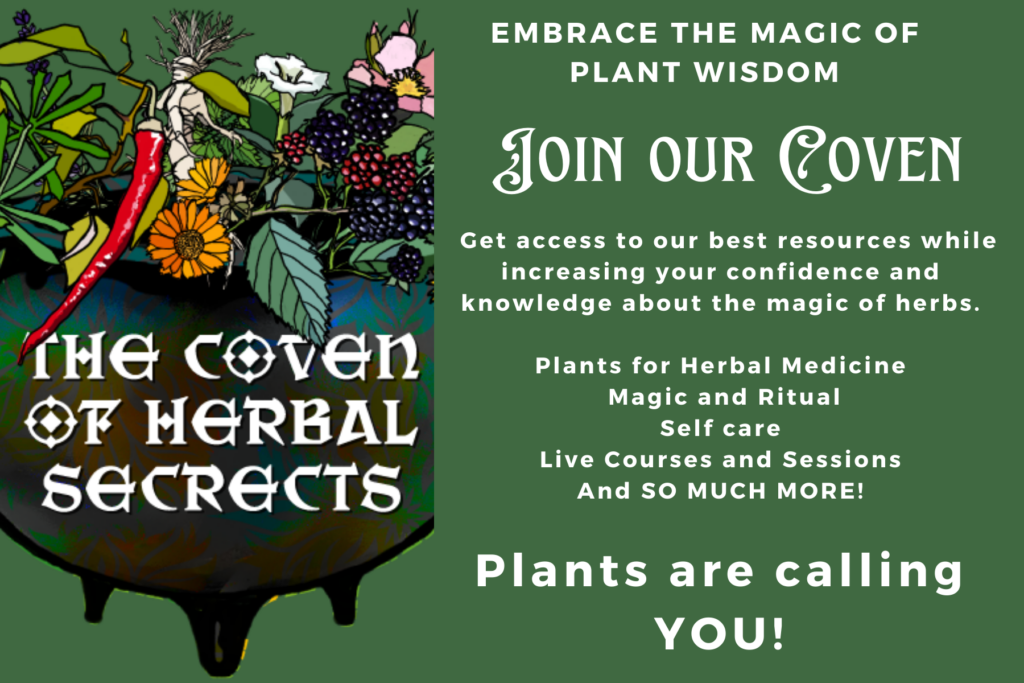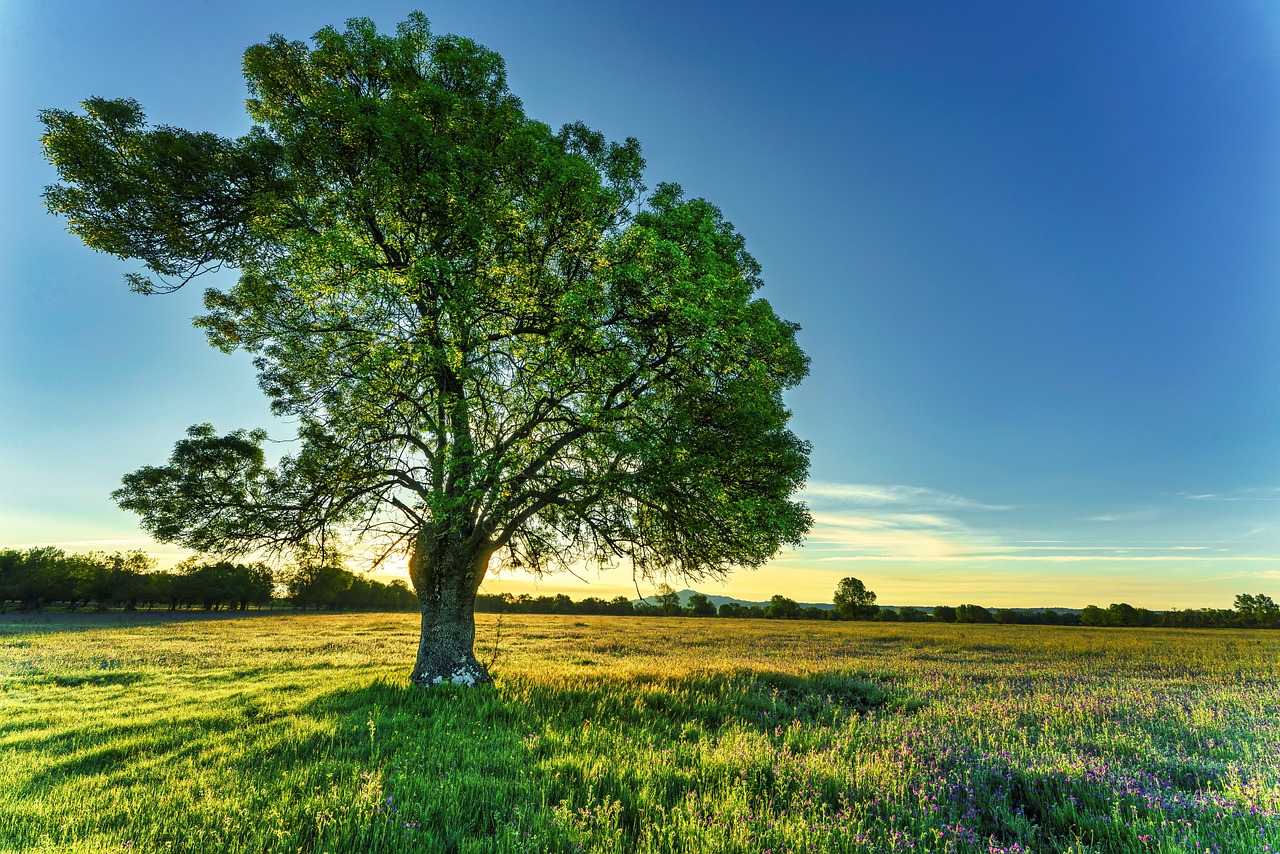We talk to a lot of concerned parents who find worms in their children’s stools. The first reaction is often repulsion and fear, which then leads to the questions of how to eradicate these unwelcome visitors. One year, our family experienced a horrible infestation, but through trial and error, I persisted with herbal treatments for threadworms with success.
Worms are parasites; similarly to nits, they make us feel violated and disgusted when they inhabit our bodies. The threadworm, also known as pinworm or seatworm, is classed as a nematode (roundworm), which is one of the most common human intestinal parasites in Britain. Children are especially prone to this, and as many as 20 to 30% of pre-school and primary-school-aged children will have threadworm infestation. Soil, unwashed fruit and vegetables can harbour worm eggs, which is where children usually pick them up. They resemble thin, white, cotton threads that wriggle unpleasantly about in stools of the infested host.
My Symptoms of Threadworms
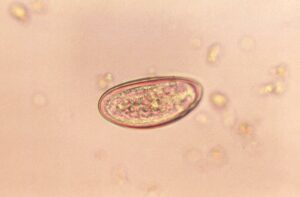 When I first found threadworms in my stool, my symptoms were an itchy bottom at night, often worse around the new and full moon. I treated myself with a very strong mixture of worming and digestive herbs – walnut, wormwood, barberry, cascara and cinnamon. I also changed my diet to cut out sugars, wheat products and supplemented it with a large amount of pumpkin seeds, grated carrots and other anti-parasitic superfoods. The worms in my stools disappeared and we thought no more of it. However, one year later I found worms in my child’s nappy.
When I first found threadworms in my stool, my symptoms were an itchy bottom at night, often worse around the new and full moon. I treated myself with a very strong mixture of worming and digestive herbs – walnut, wormwood, barberry, cascara and cinnamon. I also changed my diet to cut out sugars, wheat products and supplemented it with a large amount of pumpkin seeds, grated carrots and other anti-parasitic superfoods. The worms in my stools disappeared and we thought no more of it. However, one year later I found worms in my child’s nappy.
Children can become extremely irritable – I heard loud screaming complaints of an itchy bottom, especially at night. They can also develop dark circles under their eyes, and girls can have a very sore vagina. Other symptoms from threadworm may include digestive disorders, bedwetting, mouth blisters, anaemia, grinding teeth, hyperactivity, insomnia, irritability and nervousness.
My Herbal Treatment Strategy
The worming herbs I had given myself were very strong; wormwood is toxic at the dose needed to expel the worms. Wormwood (Artemisia absinthium) is a shrubby plant found all over the world, and in summers, it lines our roads and waste grounds. Its silvery deeply incised leaves and small yellow flowers make it quite easy to recognise and tasting this bitter leaf will soon confirm the herb is wormwood. Historically, this herb has been utilised for a variety of purposes:
Medicinal: it is a vermifuge (an agent that dispels intestinal worms)
A protection against the plague: a deterrent for vermin (especially fleas)
And as the star ingredient in the infamous drink of absinthe.
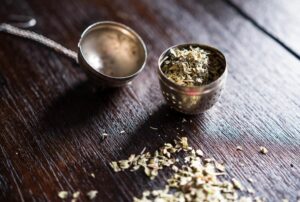 I suffered from a headache when taking it, so I was worried about giving the same mix to my child. As an alternative, I made a strong tea of chamomile and cinnamon. Hygiene is very important when treating worms. We were living in the truck on our summer tour working at festivals, so stripping and washing sheets daily wasn’t an option. I bought a plant sprayer, filling it with water and essential oils known for their anti–parasitic actions and sprayed everything, changing our sheets as often as possible.
I suffered from a headache when taking it, so I was worried about giving the same mix to my child. As an alternative, I made a strong tea of chamomile and cinnamon. Hygiene is very important when treating worms. We were living in the truck on our summer tour working at festivals, so stripping and washing sheets daily wasn’t an option. I bought a plant sprayer, filling it with water and essential oils known for their anti–parasitic actions and sprayed everything, changing our sheets as often as possible.
As a herbalist, I always want to treat an ailment with natural medicines. This route is a lot more demanding on your time and energy than buying over-the-counter drugs and being on the road constantly. As a consequence, removing the threadworm proved difficult.
After a few weeks of trying natural remedies, my 2 year old’s symptoms were still evident, and I had become reinfected. So, feeling defeated, we went to the doctor for a prescription. Everyone, including adults and those without symptoms, take a dose at the same time. This drug stops the worm’s ability to utilise glucose, whilst also inhibiting the worm’s micro tubular transport system. However, it has several side effects listed on its paperwork.
The whole family took our doses on the site of Glastonbury festival, and within hours I had a big cold sore and the rest of the family had very loose stools (not pleasant with the toilet facilities on offer!). We repeated the dose 2 weeks later as instructed, but 6 weeks later, there were more complaints of an itchy bottom from the toddler.
I felt that I had lost all control by taking the chemical drugs. That they still didn’t eradicate the worms was extremely disheartening. So, once back in the house with mod cons, I started cleaning obsessively and we made up a glycerite. This is a preparation that uses glycerine to extract the constituents from an herb.
Glycerine is both a solvent and a preservative, which is good for preparing children’s remedies because of its sweet taste and lack of alcohol. Glycerine is the sweet principle of oils, obtained by the hydrolysis of plants, usually coconut oil. You can buy organic glycerol online or in most chemists. It is a very simple process but takes 3-4 weeks for the preparation to be ready to use.
The Life Cycle of a Threadworm
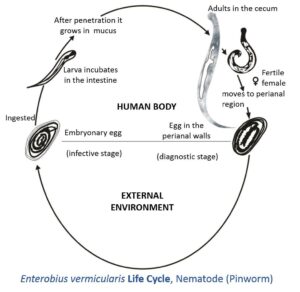 Any eggs that are swallowed, hatch and grow into adult worms in the gut so a cycle of threadworm infestation can continue relentlessly. Female threadworms survive for 5 to 13 weeks, with males surviving for around 7 weeks. The male and female threadworms mate in the ileum (last part of the small intestine), after this, the male threadworms usually die and are passed out in the stools.
Any eggs that are swallowed, hatch and grow into adult worms in the gut so a cycle of threadworm infestation can continue relentlessly. Female threadworms survive for 5 to 13 weeks, with males surviving for around 7 weeks. The male and female threadworms mate in the ileum (last part of the small intestine), after this, the male threadworms usually die and are passed out in the stools.
The impregnated female threadworms settle in the large intestine, appendix and ascending colon where they attach themselves to the mucosa or lining, and feed off the colonic contents. There, they can lay up to 16,000 eggs, with this process beginning five weeks after initial ingestion of threadworm eggs by the human host.
Before they die, the female worms lay tiny eggs around the anus, this tends to occur at night when you are warm and in bed. The eggs are too small to see without a microscope, but cause itching. People often scratch to relieve the itching without realising it in their sleep. Scratching causes the eggs to be deposited onto your fingers and under your nails, with the eggs surviving for up to two weeks outside the body.
Herbal Recipe for Threadworms
You will need:
A glass jar
Glycerol
100g cloves – these have pain relieving, anti-parasitic, anti-fungal, antiviral and anti-inflammatory properties. The cloves actually kill the eggs and stun the worms.
100g of dried flowering wormwood, which we harvested from our garden in the summer. This can be obtained from your local herbalist or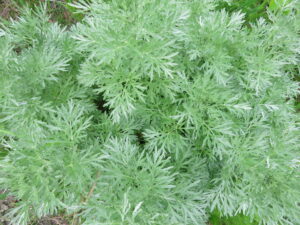 health food shop. The bitter action of this herb increases the acidity of the stomach, and the production of bile, whilst also helping to pass the worms. In this low dosage, it isn’t toxic.
health food shop. The bitter action of this herb increases the acidity of the stomach, and the production of bile, whilst also helping to pass the worms. In this low dosage, it isn’t toxic.
100g each of caraway and fennel seeds – both sedatives to the parasites.
5 cloves of chopped garlic – an astonishingly effective ‘nasties’ killer, my staple kitchen medicine. It destroys so many unwanted and harmful microorganisms.
Fill a glass jar with one and a half litres of glycerol, then add all the ingredients.
Leave the mixture to brew in a darkened cupboard for one lunar cycle.
After straining out all of the herbs and spices, you will be left with the herbal glycerol.
I gave my 2 year old one teaspoon of this mix before they went to bed, and also first thing in the morning.
Dietary Treatments for Threadworm
To help the little one pass the threadworms from their system, I made porridge with added desiccated coconut. I also included in a daily diet of grated carrot and ground pumpkin seeds. Both these have been shown to immobilise and aid in the expulsion of intestinal worms and other parasites. Chunks of cucumber have also become a staple addition to all meals, as the seeds are anti wormy.
We ate as much raw garlic as possible in all our foods. Generally speaking, children can’t handle the heat of the garlic so I crushed a few cloves up and made a poultice over the feet at night, as it still gets into the blood. I smothered the crushed garlic over the soles and put socks on – the bedroom was quite smelly though!
Worms feed on sugar, so we try to keep all sweet foods to a minimum, which can be very difficult with children. I bake cakes with agave, honey and other substitutes, but they still seem to prefer weird and wonderful, colourful sweets!
Essential Oils and Hygiene for Threadworms
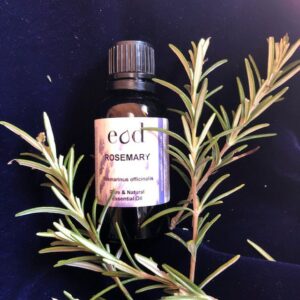 I also made a fragrant essential oil mix from lavender, rosemary, lemon, peppermint, thyme and black pepper, adding 3 drops of each to 30 mls of sweet almond oil. I rubbed this onto all our stomachs before bed.
I also made a fragrant essential oil mix from lavender, rosemary, lemon, peppermint, thyme and black pepper, adding 3 drops of each to 30 mls of sweet almond oil. I rubbed this onto all our stomachs before bed.
We washed our bottoms and hands regularly, whilst showering morning and evening using tea tree soap. I meticulously wash all our fruit and vegetables now, much of which comes straight out of our garden. Previously, I thought it wasn’t as important because we do not use pesticides or fertilisers.
We took a teaspoon of the mix morning and evening and paid special attention to New and Full Moons (when the worms are most active) by taking double the dose, so 4 teaspoons of the mix throughout the day.
After about a week on the mix, most of the little one’s symptoms disappeared, but I carried on treatment for 2 months to completely irradiate any eggs. Many folks have tried this strategy very successfully. The important thing is to be on top of hygiene and keep the sugary foods out of the diet.


